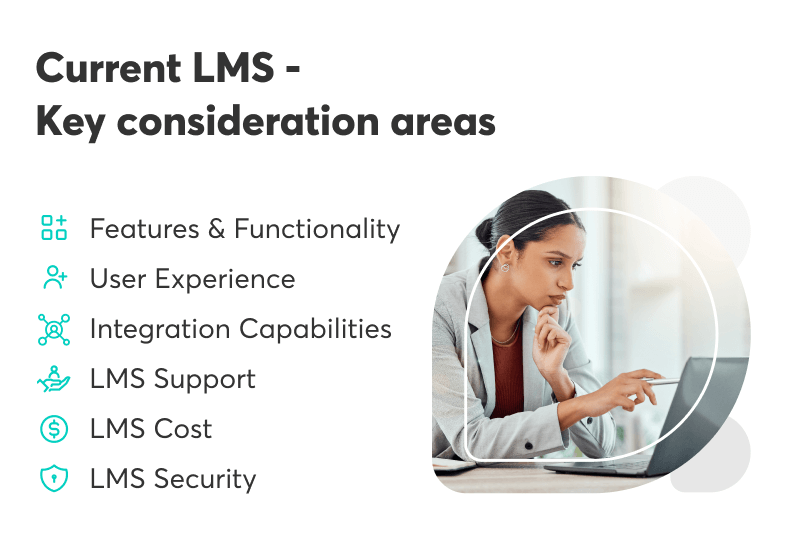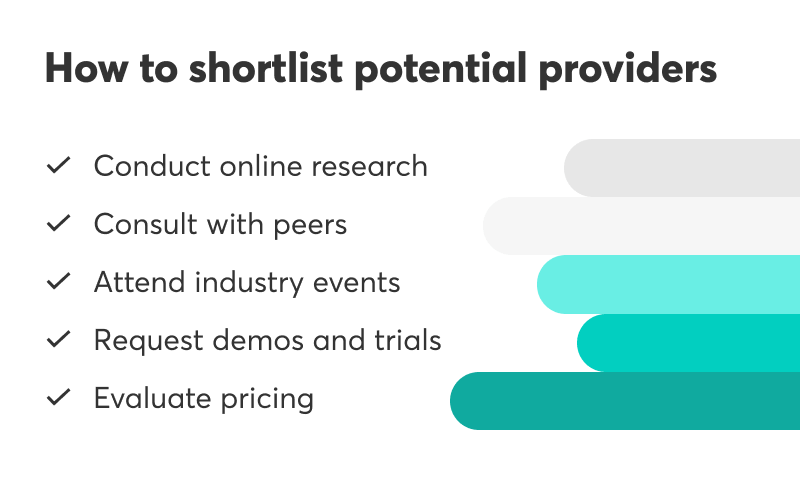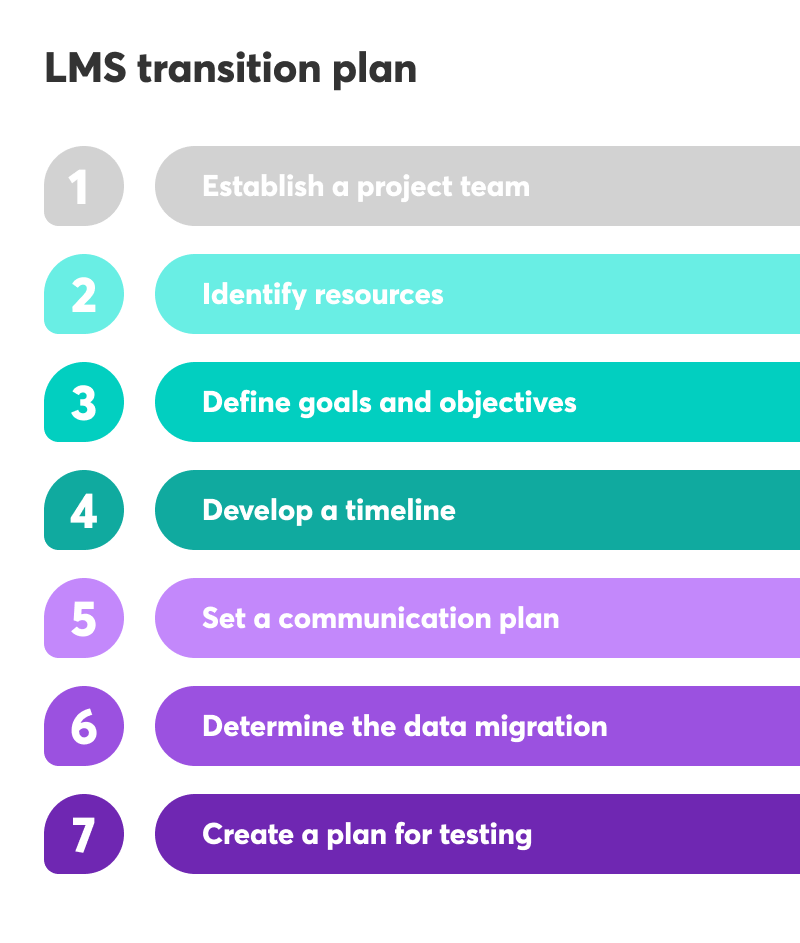Breaking Up With Your Old LMS – Can Switching Providers Be the Best Move for Your Business?

Table of Contents
The world of business is constantly evolving, and staying ahead of the game requires a workforce that is equipped with the latest skills and knowledge. That’s why having a robust Learning Management System (LMS) is essential for any organization’s success.
An LMS is a powerful software platform that enables businesses to deliver, manage, and track their employee training programs with ease. It provides a centralized and efficient way to ensure that every employee, no matter where they are located, receives consistent, high-quality training.
With an LMS, businesses can say goodbye to costly travel and accommodation expenses associated with traditional classroom-based training. It also offers the flexibility to deliver training content in a variety of formats, including interactive simulations, quizzes, and videos, making learning an enjoyable and engaging experience.
But the benefits don’t stop there. An LMS also enables businesses to track the progress of each employee’s training and identify areas where further development is needed. This allows businesses to tailor their training programs to the specific needs of their workforce, leading to improved overall business outcomes.
If you’re a business owner or manager, you already know that investing in an LMS is a smart move from a business perspective. So, it’s important to ask yourself: how satisfied are you with your current Learning Management System (LMS)? Does it meet all of your training needs and deliver the results you need to stay competitive in today’s fast-paced business world?
If you’re not completely satisfied with your current LMS, it’s time to make a change. Fortunately, our article presents a practical guide and key tips to evaluate your current LMS and smoothly transition to a better one that covers all your extensive training needs.
Table of contents
- 1Making the Switch: How to Ensure a Smooth Transition to a New LMS and Maximize Business Benefits
- 2Key Tips to Help You Maximize the Benefits of Switching LMS Providers
- 3How to Evaluate Your Business Needs to Make a Smart Switch
- 4How to Research Potential LMS Providers
- 5Develop a Comprehensive Plan for Your LMS Transition
- 6Implementing the Switch to Your New LMS
- 7Key Post-Switch Actions to Optimize Your New LMS
Making the Switch: How to Ensure a Smooth Transition to a New LMS and Maximize Business Benefits
Switching to a new LMS provider can revolutionize the way you deliver your learning content for training and education, helping you overcome the challenges associated with an ineffective or inadequate platform.
By opting for a more robust, feature-rich, and user-friendly LMS, you can provide your end-users (aka your learners, customers, partners, or employees) with an exceptional learning experience, achieve better training outcomes, and ultimately drive business growth.
If you’re considering whether it’s time to make the switch from your current LMS, you’re not alone. Many businesses have found themselves in a similar position, looking for a more effective and efficient solution.
Here are some of the most common reasons why businesses choose to switch LMS providers. How many of these boxes do you check?
Limited Features and Functionality
If you find that your current LMS provider is falling short in terms of offering the necessary features and functionalities to meet your business needs, or lacks scalability opportunities and a clear product roadmap, then it might be time to explore a more comprehensive and robust LMS platform.
Poor User Experience
An LMS with a poor user interface and usability can lead to frustration and dissatisfaction among users (learners and trainers), which can impact learner engagement and productivity. If your learners are struggling with the current LMS, it may be time to explore other options.
Lack of Support
If your current LMS provider doesn’t provide adequate support, it can be challenging to resolve issues or implement changes quickly. Inadequate support can also lead to prolonged downtime and negatively impact business operations.
High Costs
If your current LMS provider charges high fees, it can have a significant impact on your business’s bottom line. Switching to a more cost-effective LMS provider can help you save money and invest resources elsewhere.
Poor Integration Capabilities
If your current LMS provider doesn’t integrate with other critical business tools, such as HR software or customer relationship management systems (CRM), it can lead to inefficiencies and a disjointed user experience.
Key Tips to Help You Maximize the Benefits of Switching LMS Providers
Making the decision to switch LMS provider can be a daunting task for any business. While a new LMS can offer many benefits, it is essential to plan and execute a smooth transition by implementing a comprehensive migration strategy to ensure that the move is successful.
The success of the transition depends on several factors, including careful planning, effective communication, and proper training for users.
By taking a strategic and careful approach, you can minimize disruption, improve employee engagement and performance, and achieve better business results with your new LMS.
To maximize the benefits of switching your LMS provider, there are several key considerations to keep in mind. First and foremost, take the time to assess your business needs and determine the specific features, modules, and functionality required from a new LMS. By doing so, you can select a provider that best aligns with your unique requirements.
Next, it is crucial to develop a thorough transition plan. This plan should outline a timeline for the switch, delineate the tasks and responsibilities involved, and establish contingency measures to address any potential challenges that may arise during the transition process.
Open and effective communication with stakeholders is vital throughout the switch. This includes engaging with employees, management, and the new LMS provider. By clearly and timely communicating the switch and its implications, you can ensure that everyone involved understands the process and minimize resistance to change.
Providing comprehensive training and support is another essential aspect. Properly equipping users with the necessary knowledge and skills to effectively use the new LMS is crucial. Training sessions should cover the system’s features and functionality, and address any concerns or questions users may have.
Once the switch is complete, it is important to monitor and evaluate the performance of the new LMS on an ongoing basis. Regular monitoring helps identify any potential issues and ensures that the new system continues to meet your business needs. By promptly addressing any concerns, you can maximize the benefits of the switch and ensure a successful transition to a new LMS provider.
How to Evaluate Your Business Needs to Make a Smart Switch
Conduct an analysis of your current LMS

Before making the switch to a new Learning Management System (LMS), it is important to conduct a thorough analysis of your current LMS to identify any shortcomings or areas for improvement. Here are some key areas to consider when analyzing your current LMS:
Features and Functionality
What features and functionality does your current LMS offer? Are there any features missing that are essential to your business needs? Does the LMS provide an intuitive and user-friendly interface?
User Experience
What is the overall user experience with your current LMS? Are users satisfied with the platform, or do they experience difficulties or frustrations? Are users able to find the information and resources they need easily?
Integration Capabilities
Does your current LMS integrate with other critical business tools, such as HR software or customer relationship management systems? Is there a need for additional integrations to improve efficiency and productivity?
LMS Support
How responsive is the LMS provider’s support team? Are there any issues with support response times or the quality of support provided?
LMS Cost
How much does your current LMS cost? Are the costs reasonable and aligned with the value provided by the platform? Are there any hidden fees or charges?
LMS Security
How secure is your current LMS platform? Does it comply with industry security standards and regulations? Are there any security concerns or vulnerabilities?
By conducting a thorough analysis of your current LMS, you can identify areas for improvement and determine whether switching to a new LMS provider is necessary. It is important to involve stakeholders, including employees, management, and IT teams, in the analysis to ensure that all perspectives are considered.
Identify your goals and objectives for the new LMS
In addition to assessing your current LMS, it is also important to identify your business needs and requirements for a new LMS. This will help you choose an LMS provider that meets your specific needs and provides the features and functionality required for your business to succeed.
Here are some key factors to consider when identifying your goals and objectives for the new LMS:
Determine what features and functionalities are essential
When evaluating potential Learning Management System (LMS) providers, it’s important to consider various features and functionalities that can greatly impact your learning environment.
One crucial aspect to assess is the course creation and delivery capabilities of the LMS. Look for an LMS that offers an easy-to-use course creation tool and supports a wide range of content formats, including SCORM, videos, audio, and interactive media.
Additionally, check if the LMS allows you to track learner progress and completion of courses.
Another key consideration is user management. Determine whether the LMS provides user management tools such as role-based access control and user authentication. It’s also beneficial to assess whether the LMS allows easy import and export of user data.
Customization is another aspect to explore. Find out if the LMS enables you to customize its appearance to match your brand. Additionally, evaluate whether you can customize the user interface to align with your specific needs and preferences.
Reporting and analytics capabilities are essential for monitoring learner progress and assessing course effectiveness. Look for an LMS that offers robust reporting and analytics tools. It’s beneficial if the LMS allows you to export data in various formats, such as CSV or Excel.
Considering the increasing prevalence of mobile learning, it’s important to check if the LMS is mobile-compatible. Look for an LMS that offers a responsive and optimized platform for learners accessing courses on mobile devices.
Integration capabilities are also worth considering. Determine whether the LMS integrates with other critical business tools, such as HR software or customer relationship management systems. Additionally, explore whether the LMS provides an API for custom integrations.
Support is another vital aspect to assess. Determine whether the LMS provider offers responsive and knowledgeable customer support or even any migration services. Look for available support resources, such as documentation or video tutorials, that can assist you in case of any issues or queries.
Lastly, ensure that the LMS complies with industry security standards and regulations. Assess whether the provider offers data backup and disaster recovery options to safeguard your valuable learning data.
How to Research Potential LMS Providers
Embarking on the journey to find the perfect LMS provider is like venturing into a treasure hunt for the holy grail of e-learning solutions. It’s an exciting quest that can shape the future of your organization’s training and development initiatives.
In this section, we’ll show you how to research potential LMS providers and find the perfect fit for your organization. We’ll take you through the process of creating a shortlist of candidates, evaluating them based on your specific needs and requirements, and gathering important information on costs, support, and scalability.
Develop a shortlist of potential providers
Once you have assessed your needs and identified your goals and objectives for a new LMS, it’s time to start researching potential providers. There are numerous LMS providers on the market, each offering unique features and functionalities.
Here are some ways you can implement to help you develop a shortlist of potential LMS providers:

Evaluate the providers against your needs and requirements
After developing a shortlist of potential LMS providers, you need to evaluate them against your needs and requirements.
When evaluating potential LMS providers, there are several factors you should take into consideration. First and foremost, assess the features and functionalities that each provider offers and compare them with your specific needs and requirements. Look for a platform that provides the necessary tools for course creation and delivery, user management, customization, reporting and analytics, mobile compatibility, integrations, support, and security.
Another important aspect to consider is the user experience of each LMS platform. Take a close look at the user interface and determine whether it is intuitive and easy to navigate.
Additionally, consider whether the platform offers a personalized experience for learners, as this can greatly enhance engagement and satisfaction.
Scalability is another crucial factor to keep in mind. Assess whether each LMS platform has the capacity to accommodate your current needs and future growth. It’s important to ensure that the platform will be able to handle an increase in learners and courses without experiencing any performance issues.
The level of customer support provided by each LMS provider should also be evaluated. Check if they offer responsive and knowledgeable support, and determine whether support is available 24/7. It’s crucial to have reliable assistance whenever you encounter any issues or require guidance.
Pricing and contract terms are significant considerations as well. Look for providers that offer transparent pricing and flexible payment options. Evaluate the length of the contract and familiarize yourself with any cancellation or renewal policies to ensure they align with your preferences and expectations.
Lastly, consider the reputation and reliability of each provider. Look for providers that have a proven track record of delivering high-quality LMS solutions and have a strong customer base. Research their reputation in the industry and seek feedback from current or past clients to gain insights into their reliability and performance.
Develop a Comprehensive Plan for Your LMS Transition
Now that you have selected the new LMS for your business it’s time to plan and prepare a smooth and successful transition to it. Let’s explore some important steps to consider when developing a comprehensive transition plan:
Step 1 – Establish a project team
Assign a project team to oversee the LMS migration project. This team should include representatives from different departments, including HR, IT, and training. This team will be responsible for developing and executing the transition plan.
Break down the tasks required for the transition into smaller, manageable workflows. This will help to ensure that the transition stays on track and that all tasks are completed in a timely manner.
Also, a critical pre-migration step is to assign responsibilities for each task to specific team members. This includes identifying who will be responsible for data migration, testing, training, and communication.
Equally important, communicate to the project team the benefits of switching LMS providers and how it will positively impact the business. This can help to gain buy-in from stakeholders and encourage their support throughout the transition.
Keep in mind to address any FAQs or concerns that stakeholders may have about the transition to the new platform. This can include providing additional information or addressing technical issues.
Step 2 – Identify resources
Determine what resources will be required for the transition from your existing LMS to the new one, including personnel, budget, and technology. Consider any additional costs associated with the transition, such as training, LMS data migration, and custom development.
Step 3 – Define goals and objectives
Clearly define the goals and objectives for the transition. This includes identifying the desired outcomes of the new LMS and how it will support the overall goals of the business.
Step 4 – Develop a timeline
Develop a timeline for the LMS migration process that includes key milestones and deadlines and ensure that team members are aware of their deadlines. This will help to ensure that the transition stays on track and that all tasks are completed in a timely manner.
Review the timeline of the migration plan regularly and adjust as needed. This will help to ensure that any unexpected issues are addressed and that the transition stays on track.
Step 5 – Set a communication plan
Develop a communication plan that outlines how the transition will be communicated to employees, stakeholders, and customers. This should include regular updates, training sessions, and resources to help users navigate the new LMS
Step 6 – Determine the data migration
Determine how the required data will be migrated from the old system to the new one. This includes user data, online course content, and any other relevant data. Ensure that data is transferred securely and that all data is verified after the migration is complete.
Step 7 – Create a plan for testing
Develop a testing plan to ensure that the new LMS is functioning correctly before going live. This includes testing course content, user accounts, and any other critical functionality.

Implementing the Switch to Your New LMS
After selecting a new LMS provider and completing the necessary planning and preparation, the next step is to implement the switch. This involves migrating data and content to the new LMS, customizing the new LMS to meet your needs, and conducting thorough testing and quality assurance to ensure that everything is working as expected.
Migrating your data and content to a new LMS can be a breeze if you follow a streamlined process. Let’s break down the process into some simple steps that you can follow.
First things first, you need to identify the data and content that needs to be migrated from the old LMS to the new one. Take some time to determine which specific elements are important and should be transferred over to maintain a seamless learning experience.
It’s also important to get the data and content ready for migration, to ensure that everything is properly formatted and organized. This will make the transition to the new LMS a whole lot smoother. By tidying up the information and making it consistent, you’ll minimize any potential issues or inconsistencies down the road.
Next up, you need to configure the new LMS to support the migration process. This means setting up the necessary infrastructure and tools within the new system to accommodate the incoming data and content. By doing this, you’re laying a solid foundation for a successful migration.
Last but not least, put the migration to the test. Run some checks to ensure that all the data and content have made their way safely to the new LMS. This way, you can catch any hiccups or errors before going live and fix them promptly.
Key Post-Switch Actions to Optimize Your New LMS
After the new LMS has been successfully implemented, the next step is to focus on post-switch activities that ensure users are properly trained on the new system, the success of the switch is measured, and feedback is collected to make any necessary adjustments.
Train users on the new LMS
Properly training users on the new LMS is critical to ensure that they are comfortable using the new system and can maximize its benefits.
Develop a comprehensive training plan that clearly outlines the training requirements and responsibilities. This plan will serve as a roadmap for the training process and help you stay organized throughout the transition.
Next, conduct training sessions (workshops, webinars, etc.) for all users involved in the LMS. These sessions should be designed to provide thorough instruction on how to navigate and utilize the new system effectively.
Additionally, it’s crucial to provide ongoing support to users after the switch. This support ensures that they have access to assistance whenever they encounter challenges or have questions while using the new LMS. Regular check-ins, user forums, or a dedicated helpdesk can be valuable resources to maintain user satisfaction and encourage continued usage of the system.
Measure the success of the switch
Measuring the success of your LMS switch is crucial in assessing whether it has effectively achieved its intended goals and objectives. To properly evaluate the impact of the switch, it is important to follow a systematic approach.
First, you need to establish success metrics that will serve as indicators of the switch’s impact on the business. These metrics should be carefully chosen to align with the specific goals and objectives set for the switch.
💁 For example, success metrics could include improved user engagement, increased productivity, cost savings, or enhanced customer satisfaction.
Once the success metrics have been established, the next step is to collect relevant data that can be used to measure and analyze the switch’s performance. This data can be gathered from various sources, such as user feedback, system logs, performance indicators, or surveys.
It is important to ensure that the data collected is comprehensive and representative of the switch’s impact across different aspects of the business.
With the data collected, the next step is to analyze it thoroughly. This involves examining the data in relation to the success metrics established earlier. The analysis should aim to determine whether the switch has achieved its intended goals and objectives. It may involve identifying trends, patterns, or correlations in the data that can provide insights into the switch’s impact.
This evaluation process allows for continuous improvement and adjustment to ensure the long-term success of the switch and its alignment with the business objectives.
Level Up Your Business with a Smooth LMS Switch: Try LearnWorlds for Free!
Switching from your current system to a new LMS provider can be a game-changer for your business! It can lead to improved user experience, increased engagement, and better learning outcomes. But to make sure the switch is a success, it’s crucial to plan and execute a smooth transition.
While it may seem intimidating at first, finding the right LMS can be a breeze with a well-organized process in place. The effort put into the search will be worthwhile as it ensures that you select an LMS that perfectly aligns with your business requirements.
To make things even easier, we invite you to try LearnWorlds for 30 days for free! With its wide range of features and functionalities, LearnWorlds is a powerful, flexible, and user-friendly LMS that can help you deliver engaging and effective online training and learning programs.
Rosemary is LearnWorlds’ Content Marketing Manager. She has over 2 decades of experience in omnichannel marketing and content writing for the IT and SaaS industry. Her expertise lies in crafting effective content marketing strategies that attract, engage, and nurture customers, enabling LearnWorlds to reach its target audiences with precision.


